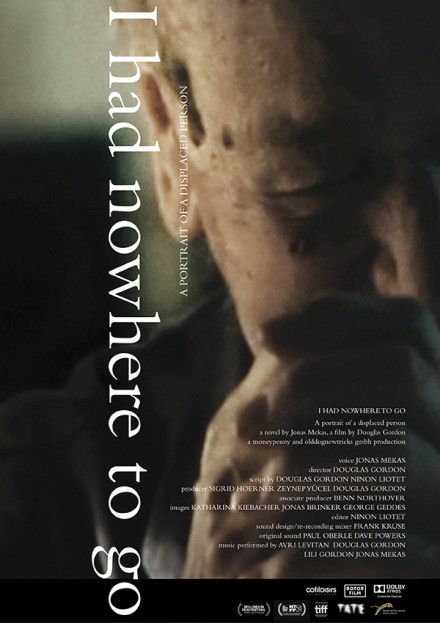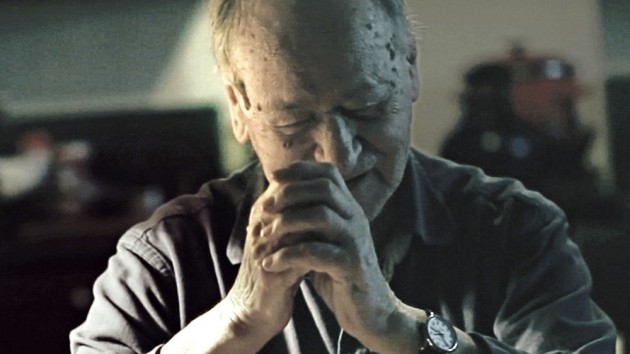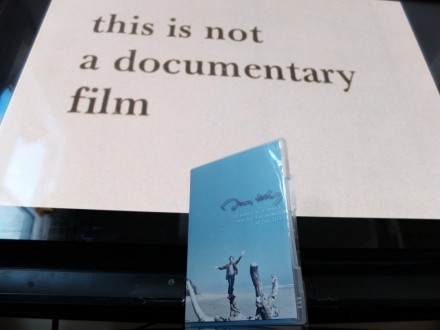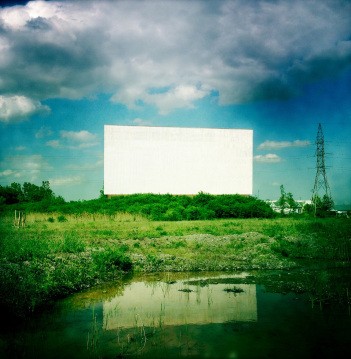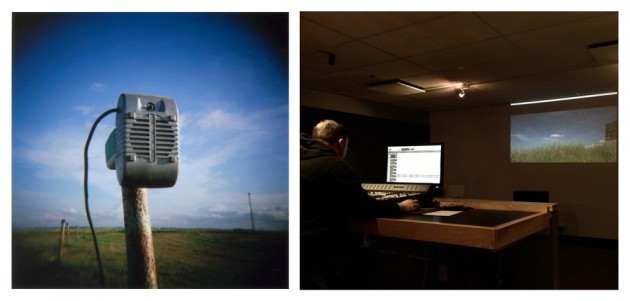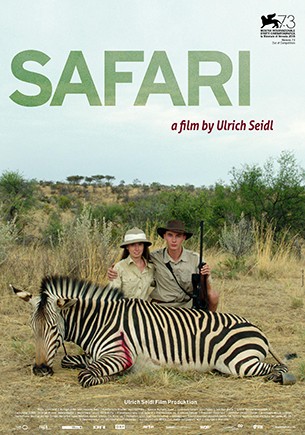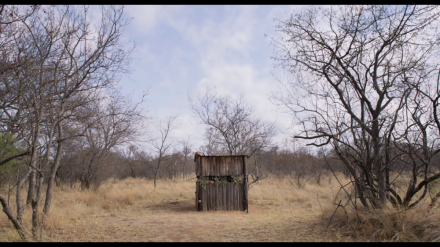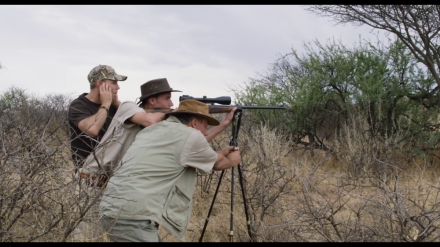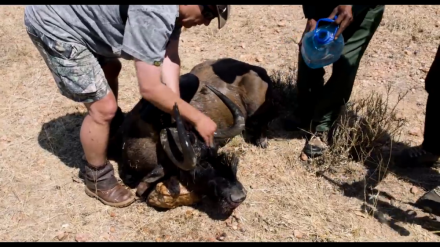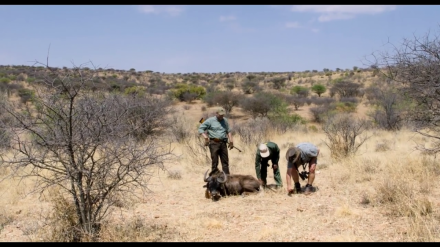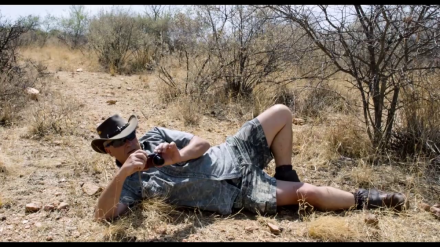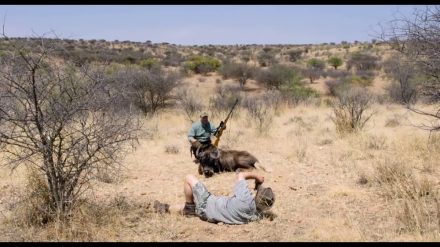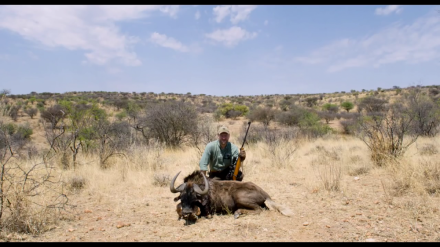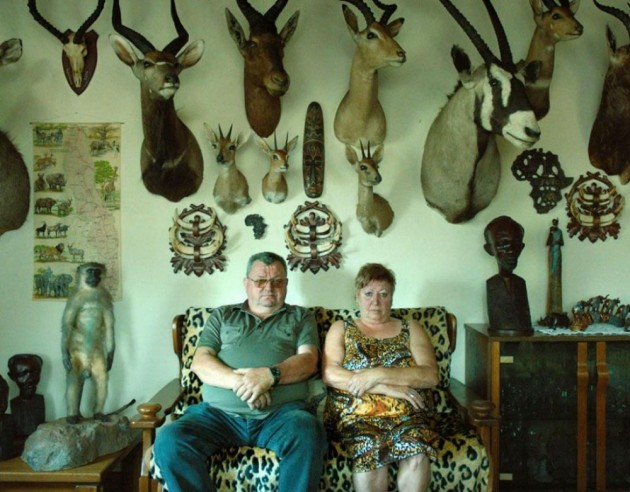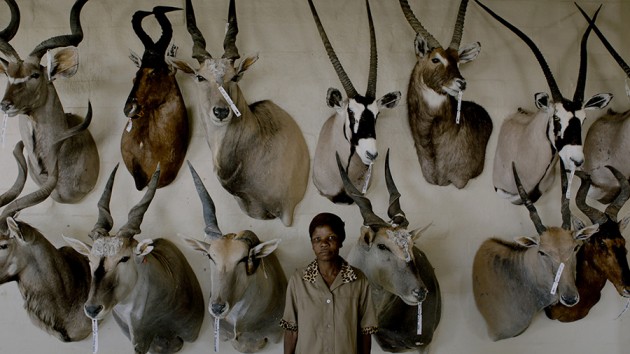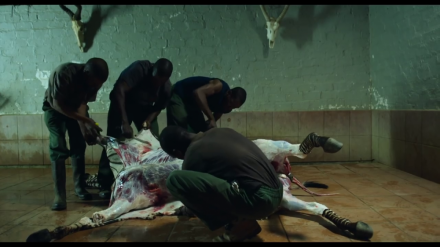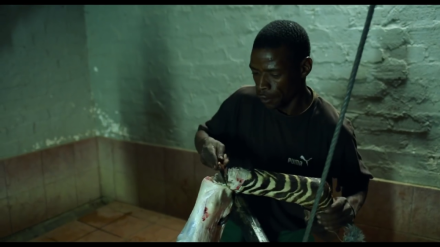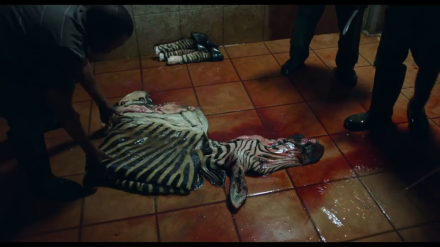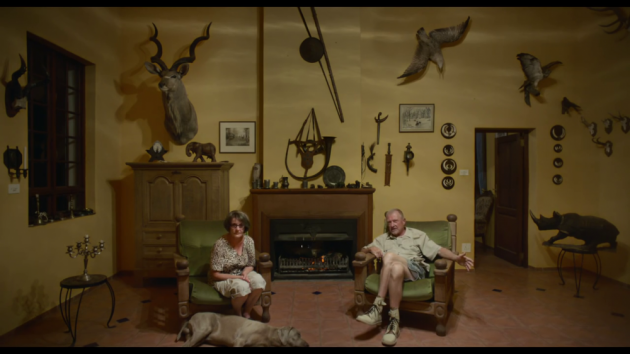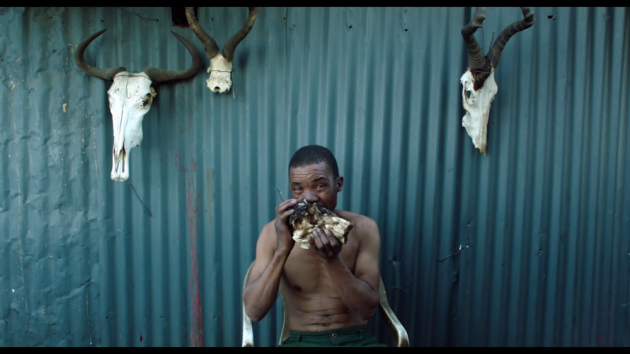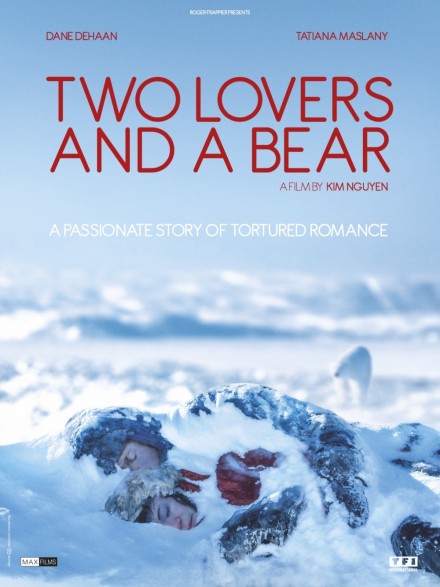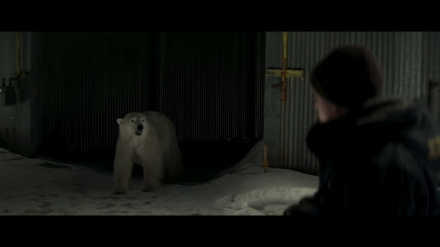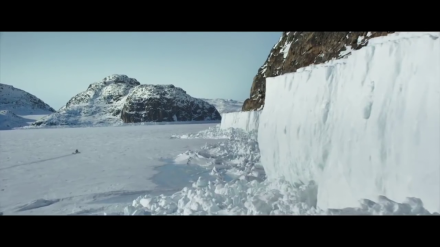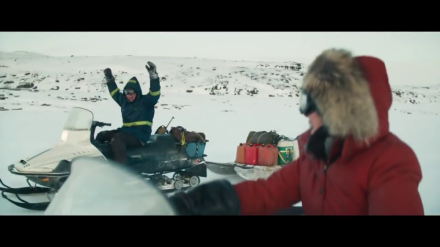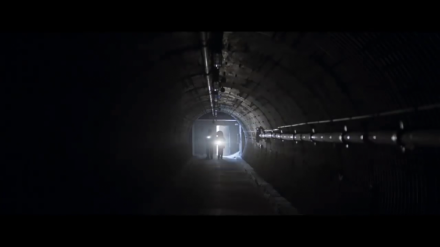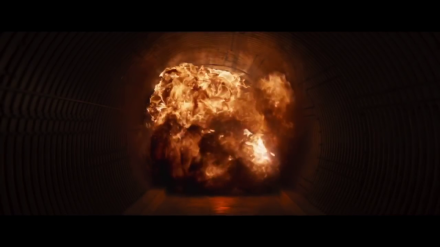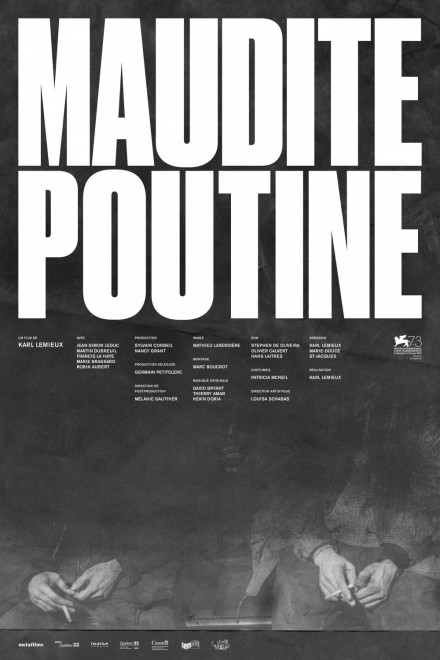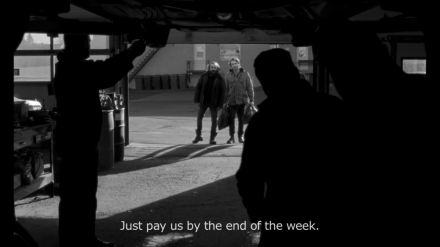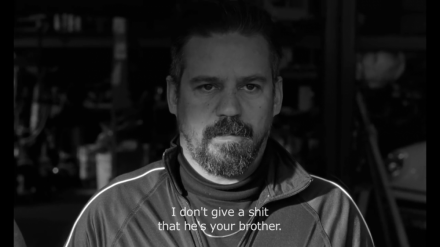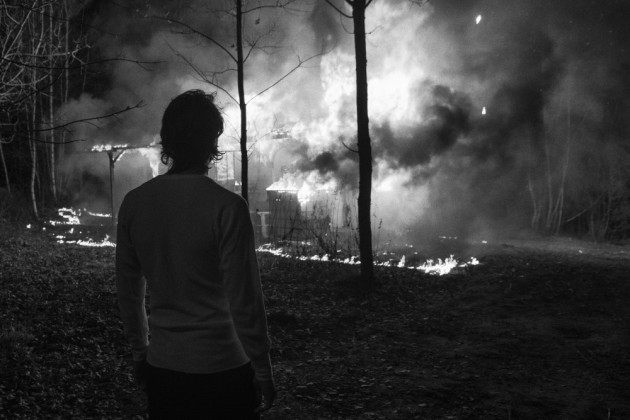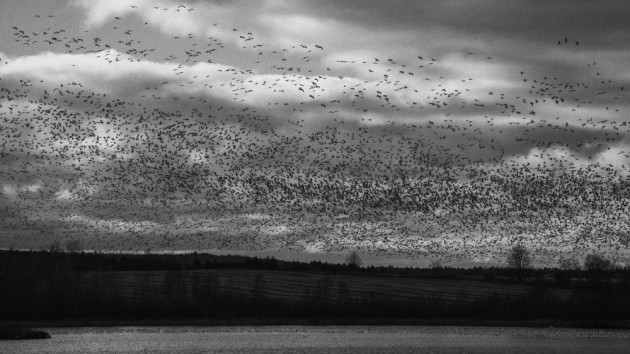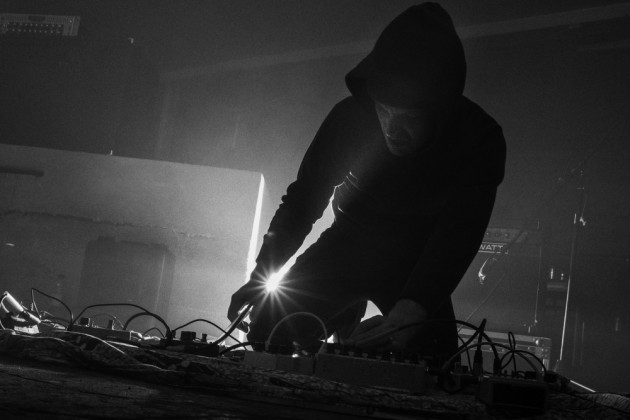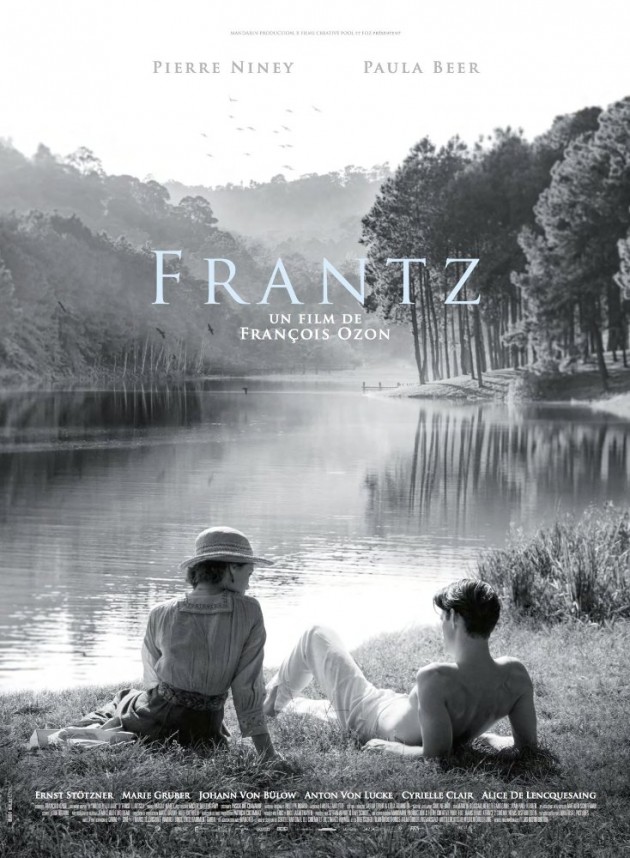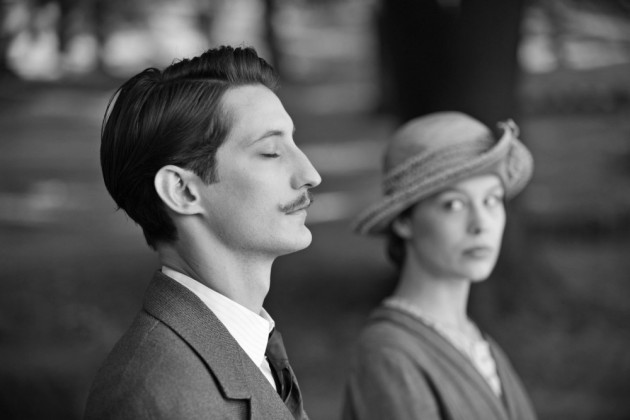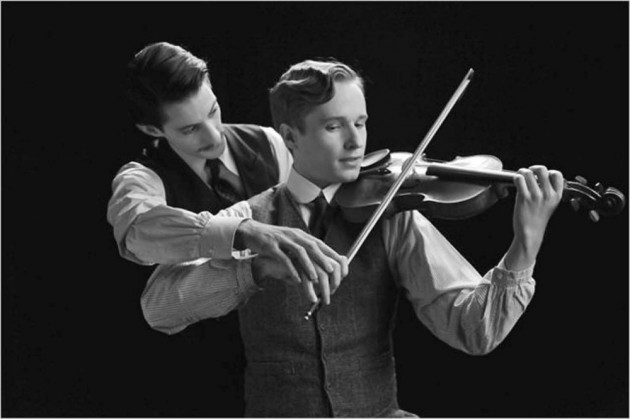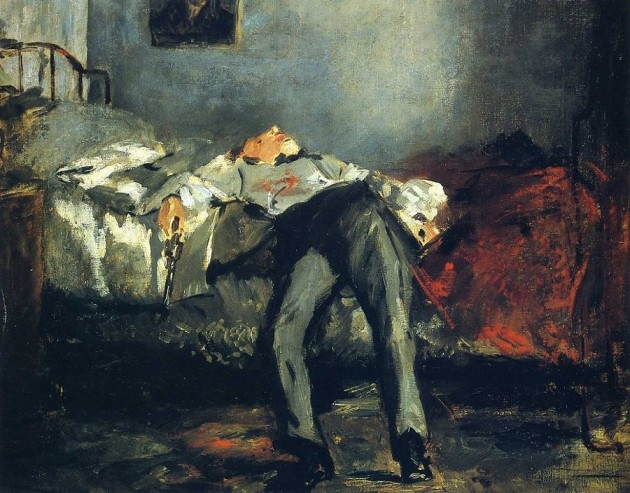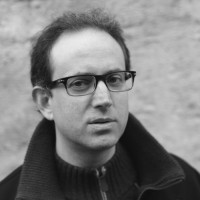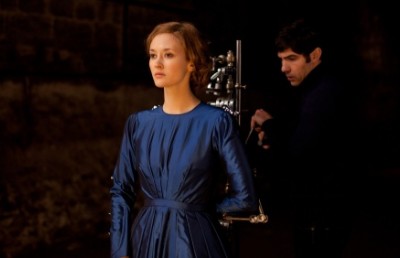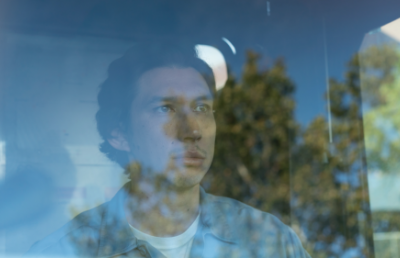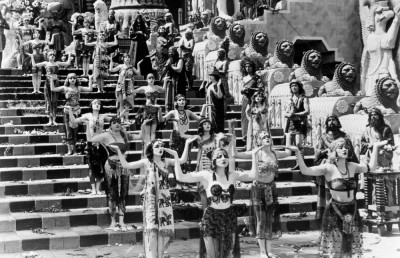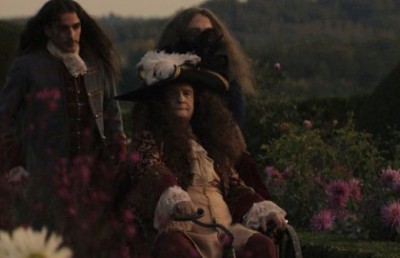Displacements: Geographies of Flight at Festival du Nouveau Cinéma 2016

It’s dark. An urban soundscape. The film is about Jonas Mekas, so I think of New York. Slowly the sirens reverberating off of glass and concrete give way to a propeller plane coming in for a landing followed by the sound of wind in the trees and a dog barking. We have become displaced before a single image appears on the screen, and with this simple auditory gesture we are given the very premise of the film: that Douglas Gordon will situate the audience within an aesthetics of displacement as a mode of access to the story of Mekas’ own flight from home. So Gordon begins with a backtrack, moving from the city most marked by Mekas back to the place from which he came, where the story will begin.
My first impression was that these moving sounds in the dark would prove a bold opening to a film that might be a little heavy on the talking head. But in fact there are very few images in the film, and we see Mekas only once. Right after this opening, when he tells us the story of his first photograph. It’s a telling one, in which he, as an adolescent, photographs Soviet troops invading his hometown. As I listen to his description of a charged situation, I wonder if we’ll get to see the image. The answer is no, as he explains that he was spotted and the film ripped out of his camera and destroyed. They didn’t destroy the camera, and they let him go. And go he did, with his brother Adolfas, on a refugee trek across Europe and ultimately to New York City.
The film thus opens its premise of dislocation by emphasizing the ephemerality of the recorded image, which hangs in tension with the documentary impulse that must govern any filmmaker’s interest in capturing the world. True of Mekas in particular, whose films are immersions in the fleeting quality of lives in passing. Gordon has been critiqued for not engaging with Mekas’ filmmaking, or his legacy for filmmaking in New York. But in his film’s insistence on contemplating the geographies of dislocation, his work is a bold excursion into Mekas’ world indeed.
After we watch Mekas tell the story of his first photograph, we plunge back into the darkness as he describes how New York looked upon his first arrival. Now it seems clearer that we won’t be graced with an image to corroborate the words we hear, and that this will be the governing theme of the film, a structured engagement with the experience of displacement by way of a sustained dislocation of sound from image. But this wouldn’t work if we simply remained in darkness for the whole film while listening to Mekas speak. That would be radio. Occasionally some colour emerges, and once in a while we are confronted with an image.
A bare foot on snow. Potatoes and turnips cooking in a pot with embers. A monkey sitting in a cage. The immediate impulse is to connect these images with what we hear simultaneously on the soundtrack, an impulse that ignores the very premise of the film. Are we meant to associate the monkey in a cage with Mekas’ ongoing discussions of prison camps and otherwise confined quarters strung together on his flight from fascism? That would be too easy, and a trap that The Guardian’s Jonathan Jones falls into when criticizing the film for being too overt in its audiovisual analogies. 1 The image of the monkey is explained later as Mekas tells us about a trip to the Hamburg Zoo after the war, all but destroyed, only one chimp left. Rather than a symbol of entrapment, forged by the habit of correlating the meaning of sounds and images presented in synchronization, it becomes a marker of displacement: you can never go home again. Nothing will ever be the same. The things we remember, like the style of cooking potatoes that is also later explained, are gone. In the tradition of Hollis Frampton’s Nostalgia, Gordon tests the audience’s capacity for memory as a very function of the exercise of instilling not the horrors of war but the experience of displacement itself. If we can’t connect the images we see with the stories Mekas tells us, separated by long passages of the film, then we already know a bit about what it’s like to be displaced, losing our ability to connect new circumstances with the things we already know. And if we can connect the dots, then we understand the deliberate structure of the film. Either way, we are immersed in displacement.
Mekas’ stories, too, are presented in a displaced fashion, jumping back and forth from the progression of his flight across Europe to his first few weeks in New York. As such we are continually asked to understand his joy at relatively banal and bleak conditions in NYC in the context of the restlessness and exhaustion of his escape from Lithuania. This is another of Gordon’s main contributions to interpreting the diaries upon which the film is based, originally presented in a linear fashion.
A colleague of mine complained about the duration of the black screen passages that do indeed take up the majority of the film’s running time. He argued that this strategy would work better in a gallery. And indeed, a gallery version is on tour simultaneous with the film’s festival run. However, the gallery version is constructed as a multi-screen environment in which the relationship between the film’s few images and its soundtrack is changed, largely on the point of duration. Though I haven’t seen the gallery version, it is clear from the images available online that the audience is given several things to look at simultaneously while listening to Mekas’ stories, altering the dynamic of displacement present in the single-channel film version. This speaks to Gordon’s differing intentions for the two versions, and why the long passages in the dark are so important in the context of the traditional black-box cinema presentation. In a gallery, very few would submit to the lengths of listening required for the film to have its effect, and the intensity of the experience of displacement between what we hear and what we see would thus shift to more of an exercise in continual recontextualization. Gordon’s decision to render the gallery version as a multi-screen environment is wise, because it gives the audience some agency in moving around the space and experiencing the film’s associations in a variety of different ways without having to sit for too long at any given moment. And I’m sure that some new and interesting associations emerge, variable across the experience of each audience member who steps in, around, and out in differing ways. But this also highlights what Gordon was after in the film version, with so much emphasis put on sitting and listening in the dark while pondering an image or two at some distance from the present moment. The astounding quality of the sound design in Gordon’s film requires that we listen intently at length, without the distraction of the choice offered in the gallery setting. A cinema is one of the only places left where that’s possible. At the same time, this listening in the dark is always rewarded by a corollary image, albeit asynchronously. And that’s the beauty. The displacement Mekas describes in his journey from Lithuania to the U.S. lives through the film’s formal displacement of sound and image. We are invited to think about the relationships between what we see and hear across time, and to ponder the passage of time, one of the key components of Mekas’ own story.
The film’s sonic peak comes with an extended passage of shell sounds rising and falling in dynamic range, bouncing around the surround speakers, continually surprising with its evocations of distance and encroachment. This is an exquisite spatial construction provided as auditory illustration of a story Mekas tells separately. He details how workers in the German munitions factory where he was enslaved were so relieved when the air-raid sirens would go off because it meant an extended break from the relentlessness of the assembly line. They would go outside and lie on the grass, falling asleep without heed of the sound of bombing at a distance. In this context, listening to the shell sounds continually challenging and surprising our sense of distance through the filmmakers’ play with spatial cues, is exquisite and powerful indeed. And impossible to achieve without a captive audience. For the film to do its spatial work, the listener must be immobile.
Some have complained that Gordon misses an important opportunity by not engaging with Mekas’ own filmmaking or the incomparable legacy he has left in New York City. But the experience of I Had Nowhere to Go, as an enactment of the sense of displacement that has fueled Mekas’ commitment to his adopted home, is a venerable homage to Mekas’ work and an experience that won’t be replicated. In many ways Mekas has been his own best documentarian, and Gordon was wise not to replicate Mekas’ own work. Indeed, I Had Nowhere to Go is very much the antithesis of a Mekas’ film in which moments pass quickly, shots are short, and in-camera “cutting” is relentlessly fast paced. Nowhere is this clearer than his 1984, He Stands in the Desert Counting the Moments of His Life, recently released on DVD for the first time, which he describes as consisting of impersonal tidbits documenting events he participated in but viewed at a distance. Here the grandiose becomes leveled with the mundane. Hollis Frampton gets buried. George Markopolous is in the hospital, then at the crematorium. John Lennon plays basketball with Miles Davis. Andy Warhol frames a shot while vacationing with the Mekas’ in Montauk. And Mekas re-stages the Lumieres’ Arrival of a Train on location at Le Ciotat Station. The moments fly by, here untempered even by Mekas’ own characteristic narration, one way in which the film is clearly depersonalized compared to something like As I Was Moving Ahead Occasionally I Saw Brief Glimpses of Beauty (which I reviewed in my report on FNC 2001). The contrast with Gordon’s film is striking, all the emphasis put on duration, of the gravity of the moments Mekas describes, and what few images do appear, we’re given the opportunity to ponder at length, often unmoving, an impossible task in Mekas’ own work. As such I Had Nowhere to Go stands as incomparable complement to Mekas’ life and work.
Mekas has described his images as being more real than the reality they captured, for they still exist while the events, and even their memories, are long gone. In Broken Altar, Mike Rollo reverses this scenario, lingering over the abandoned screens of overgrown drive-in theatre lots, blank canvases across which so many images have passed, now lost forever. But like Gordon’s film, the sound is deep as we ponder the absences here, conjuring up lives both past and present in these now wild locations. More than ruminating upon an age now gone, the film asks us to consider the nature of the screen itself, as if asking: what is the cinema to be? Is there a cinema in the absence of images on a screen? The black box survives, and mobile media proliferates. But drive-in is neither, a fixity premised upon mobility, a situation that Rollo enacts by way of his moving camera, injecting trajectories of shifting perspective onto elements that are invariably still, save for the rustle of grass in the wind or a swing set drifting as though occupied by ghosts of moviegoers past.
While the image track investigates these locations from a decidedly naturalist position, the sound track roams free into realms of abstraction that fills the empty spaces with a sense of depth, as though layers and layers of the history of film sounds have collected in these spaces, piling up and dissolving through each other to create something unrecognizable. Many of the elements were culled from recordings made on location with heavy manipulation in post-production. At times there is no tangible connection between what we hear and see, the sounds operating as though a lit screen in the dark taking audiences away to places far removed from these rural climes. Other times the synchronization is palpable, as when we see the remnants of the speaker systems at one theatre, some still hanging on their posts, some lying broken on the ground, as the sound of an old movie soundtrack emerges, reverberating as though with the distance of time, a title taken from one of the posters he found on site. On the whole I’d like to hear less ominous drones and more nuance in the development of these physical locations treated so reverentially by the camera. As Gordon’s film continually reminds us, there is something highly charged about geographic locations as they connect with the people who move through them, and there’s room here to meditate more deeply on the nature of these spaces sonically. But the film is remarkable nonetheless, an important pause for reflection upon the nature of cinema itself in our age of mobile media.
Where I Had Nowhere to Go plays on the distance between its sounds and images, and Broken Altar shifts registers between acousmatic-style musical treatments and naturalist environmental sound, Ulrich Seidl’s Safari went all the way to the latter end of the spectrum while accompanying vacationers on big game hunt at the German-owned Leopard Lodge in Namibia. Here, its emphasis on location sound becomes highly politicized as the film unravels the enigma of a subject that becomes increasingly complex as it goes.
Following a prologue showing us a lone piper sounding the start of the hunt, the film begins in remarkable quietude. A bluff is framed in long shot. Like the animals it’s set up to deceive, we can’t see if there’s anyone inside. Time passes. A few seconds? A minute? Enough for the sudden shot that rings out to cause some in this 10 am audience filled with grizzled Montreal press lifers to jump out of their seats. This was one of the few times I was happy to be at the press screening rather than with the festival public. Some of these folks need a little wake-me-up.
Ulrich Seidl’s films are often described as dispassionate and distant observations of controversial topics, but there’s a catch here: as we follow various hunting groups through the killing of a wildebeest, zebra, and giraffe, the handheld camera always flinches when the gun goes off. Always. A natural reflex to be sure. But it belies a proximity to the subject matter as well, for it’s clear through the film’s construction that the intensity of the juxtaposition between quietude and gunfire is meant to play out across the juxtapositions that unfold in Ulrich’s compositions and editing strategies throughout.
One of the film’s most remarkable achievements, on the level of production, is the footage of the lodge patrons on the hunt. Animals die, often horribly. If it’s hard for us to watch, it’s because we’ve been sheltered from that reality. Nowhere more evident that in the final kill of the film, the giraffe, whose collapse we watch in gruesome detail, kneeling, unable to stand up as it swings its head back and forth. And the camera lingers. We’re made to witness in full, and in so doing Seidl positions us with the handful of other giraffes barely visible in the distance, standing motionless, watching. “Why are they still there?” asks one of the hunters. The question isn’t answered, but the implication is clear: why are we still watching?
Seidl’s lingering camera also stands with the hunters, reveling in death through their elaborate construction of trophy shots, posing the animals in the field for snapshots with those responsible for their deaths. In each case, after the hunters have secured their photos, Seidl presents his own portrait of each kill, staged as a still shot from the perspective of the still cameras, but not in freeze frame. The animal is still because it’s dead. The hunters are still because they’re posing. But the trees and grass blow in the breeze around them. The birds and insects chirp and buzz. The artifice is exposed, but these are also moments of repose in the field, denouement after the tension of the chase. The hunters describe intense emotion at the moment of the shot. Here Seidl is capturing the release after the fact.
So what are we meant to think about these wealthy German white folk killing animals for sport on poor black land? At first, the conundrum seems liable to hypocrisy. The hunters are easy targets for liberal condescension. But we all draw our lines. Whether we eat meat or not, we kill things as a function of maintaining our own lives. Swat mosquitos? Eat vegetables? Draw the line at sentience? Or cuteness? We know that plants talk to each other. What are vegans going to do when science inevitably discovers their consciousness (if it hasn’t already)? Indigenous peoples the world over have known forever that life must consume life, but that it must be done from a place of spiritual and ecological respect. Here the lengthy interview segments with the hunters reveal much. Composed in wide shots that expose the grandeur of the lodge’s various halls, filled with trophy heads of all kinds, the hunters draw varying and sometimes contradictory lines about what they will or won’t kill, and why. There is room for identification here. But it’s Seidl’s ruse. Those of us who thought the film’s substance might lie in its investigation of the discourse of killing animals would soon be taken for a ride.
The film’s second half takes us backstage to reveal the inner workings of the lodge, drawing formal parallels with the white guests as Seidl composes shots of the black staff against the trophy backdrops in storage and then on to see their living quarters, meals, and the dirty work of processing the carcasses to harvest the trophy heads and skins.
Here the ethical questions around treatment of life are reframed around the politics of imperialism. The owner of the lodge is interviewed to reveal a startling take on his profit taking on foreign soil. In the bigger picture, he says, wildlife is doomed. Climate change is destroying the planet, and the only reason the animals on his reserve are there is because of the artificially created protection he affords them for the very purpose of killing them.
This is, in fact, a strain of legitimate philosophical argument in the animal rights field. Many of the animals we eat are only in existence because we eat them. If we want to respect their right to continue to live as a species, we have a duty to eat them lest they fall out of the interest of cultivating human hands. Or so the argument goes. But the owner’s rationale is quickly juxtaposed with interviews of various hunters about their relationship to the black community on which their sport is premised. They speak in varying degrees of condescension, from testimonials like “I get along with them just fine” down to the owner’s wife revealing her own eugenically inclined beliefs as she describes black people’s “superior” build for physical activity – should they “feel like” doing any. After which Seidl makes loaded cuts to images of the black staff eating the remains of the trophies they’ve processed for their employers. Pair this with the lodge owner’s suggestion that overpopulation is the most vital threat to the planet, and the underpinnings of the ideology of “ethnic cleansing” are laid bare.
Here there is no longer any escaping the reality that the film reveals. When we see black workers framed against the wall of trophies, we understand that they, too, are trophies for these German lodgers, who think of them as not too far removed from the animals they prize, whose trophy-adorned rooms often contain carved busts of black people as well. While the lodge guests are happy to pull the trigger from a distance, it is the lodge staff who get in there and deal with the mess that ensues, leaving the glory of the cleansed final product to those who will take them home and display them without any evidence of the colonialist basis of the whole enterprise. And the film displays a tremendous care of pacing and editorial savvy as it saves the most troubling hunt footage – the giraffe – for a moment in the film after we have gleaned the darker side of the issues underlying the question of displacement in the colonial exercise. Nasty business all around, all the more terrifying in light of the racial intolerance enabled by the rise of Donald Trump to the presidency of the United States of America. This shit is real, it has always been there, and it doesn’t take much to force it back up to the surface.
For a 180 degree turn on the relationship between humans and the beasts of the wilderness, Kim Nguyen’s Two Lovers and a Bear proved a useful probe of the issue of displaced peoples on the land in the process of exercising their demons. The film finds us catching up with two lovers on the cusp of separation in a small town in Canada’s far north. Lucy, a local, gets accepted to school down south and must take the opportunity if she’s to move forward in her career, and escape the ghost of her abusive father who continues to haunt her in broad daylight long after his death. Roman is from the south, hiding out up north to escape his own demons left behind in warmer climes. He doesn’t want to go with her for fear of reawakening the horrors of his past, and so he holes up with a few illicit bottles for the days leading up to her departure, unwilling to engage with her at all. Until a local bear talks him back to his senses. Maybe.
The couple decides to make a “road” trip out of it, saddling up a couple of snowmobiles and heading out across the tundra.
They survive a few mishaps, including an impressive scene in which they wait out a storm in a deserted military outpost, which they end up torching in order to purge her father’s ghost once and for all.
But it’s all for not as they eventually run out of supplies and end up freezing to death in a snow cave. The final image is striking, the two lovers interlocked in a sleeping embrace, frozen solid in a block of ice that is cut out by rescuers and airlifted home on a helicopter.
At only 90 minutes, I wish the film had taken longer to get this final image. The film is packed full of material that could have been better developed, like the ghosts that haunt these two, her indigenous ancestry, how he came to be able to speak with the bears. With the strength of the film’s two principal actors, along with the enormity of the production value inherent to the film’s shooting locations, they could have easily spent another half hour meditating on the land, taking more time with things, building a stronger sense of the relationship between this place and the situation these two find themselves in. For the north is home to some, but so often populated by those at the end of their line, nowhere left to go, running from the world to the south until they are forced by geography to sit still. Things take their time up there, but the film felt like it was trying a bit too hard to adapt that environment for impatient southern audiences.
The specters of familial demons haunt Karl Lemieux’s Maudite Poutine as well, the story of an estranged man, displaced from his family, reconnecting with his younger brother in a time of distress. This is the first feature film for this Montreal-based filmmaker, known to many of us for his multi-projector live film manipulations in and around the Double Negative Collective and, especially, his collaborations with Godspeed You! Black Emperor, most recently at Théâtre Paradoxe this past September.
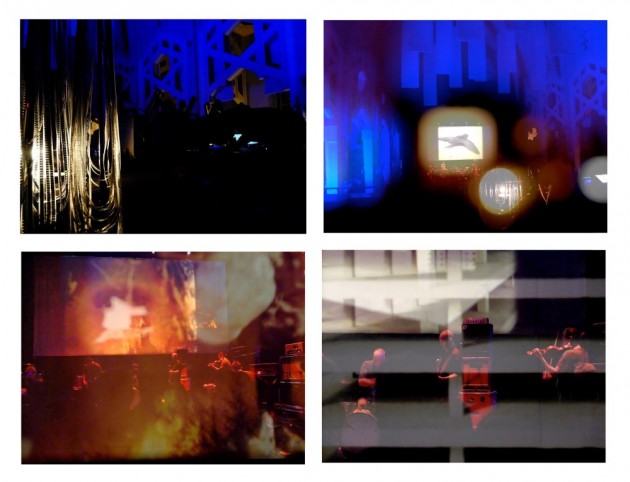
My photographs of Lemieux’s projections for Godspeed’s 2016 run at Théâtre Paradoxe in Montreal.
A deft handler of celluloid in real-time, his highly avant-garde leanings have translated into a variety of short film projects over the past two decades. But I’ve always wondered what would happen if he moved into the domain of the narrative feature. This year we got our answer. In many ways, Maudite Poutine expands on the tone of his last short film Passage (2008) (available to watch on Lemieux’s Vimeo site). A dark but superbly shot joy ride out to a cabin in the country where an intoxicated betrayal of friendship unfolds with almost no dialogue and a palpable sense of unease that reminded me both in aesthetic tone and narrative content of the work of Philippe Grandrieux. This is high praise, as I am “on record a big fan of” Grandrieux’s work. And there is a scene in the middle of Maudite Poutine that replicates Passage as the main character heads out for a night of partying with his band and some hangers-on, one of many passages that provide the oneiric thread that binds the film’s story together.
Although the best moments in Maudite Poutine were those that leaned towards the experimental nature of Passage, Lemieux handled the requirements of dialogue and character development here very well. A pair of estranged siblings is forced into reconnection when the misdeed of the younger finds him crossing paths with the older for the first time in many moons. Vincent, the younger brother, steals some weed from local thugs in an attempt to raise funds for studio equipment for the noise-rock band in which he is the drummer. They get busted by the gang, and the film opens with the three hapless musicians hauled off to a deserted warehouse to be taken one by one upstairs and pummeled. Vincent, however, is spared when he discovers his older brother, Michel, acting as guard for the gang. Michel won’t talk to his younger brother there, but his influence prevents a beating. Later Vincent goes to find Michel, who is hiding out at their deceased father’s trailer, smoking crack and blasting thrash metal, apparently en route to the same self-destruction that engrossed their dad. Ultimately Michel is sympathetic to Vincent’s cause, feeling somewhat responsible for abandoning his little brother, and ends up putting himself on the line to try and call off the gangsters. But they won’t back down, and unless Vincent raises ten grand soon his life is in danger.
The tension around this situation causes a resurfacing of the various interfamilial dynamics that caused the Michel’s displacement from the family and, further back, the death of their father. Things spiral out of control and Michel ends up torching his father’s trailer and burning himself up inside it as Vincent watches, unbeknownst to Michel, from outside.
Lemieux delivers the information out of sequence, however, and we’re first led to believe that it was the gangsters who set the blaze as warning to Vincent to cough up the cash. But with absolutely no resources, Vincent, now in despair, confronts the gangsters with a pistol turned on himself in a one-sided game of Russian Roulette, a desperate move to either call out the gangster’s bluff or force his hand and put an end to his despair once and for all. The film ends, remarkably, by the gangster empathizing with the young man, bringing him into the garage, sitting him down, and helping him come down off of his bad trip. It’s only after this that we get a flashback to his older brother spreading gas around the trailer and tying himself to the bed before lighting a match, allowing us to recontextualize the scene prior. Vincent is told to get out of town, and the film ends on a positive note that he may just be able to remake his life by displacing to another location, suggested by some remarkable footage of birds in synchronized flight.
The film benefits from Lemieux’s relationship with the Godspeed You! Black Emperor family, scored largely with tracks from the band’s Set Fire to Flames side project, long a favourite of mine for its distillation of the darkest and quietest passages of the official repertoire and extending these into new territory. There are moments of brilliant cinematic flourish, as in the fire sequence, which looks a lot like some of the footage used at the Godspeed shows a couple of weeks prior. And there’s a tremendous sonic treatment in a moment of musical performance midway through the film when images of Vincent performing on stage are combined first with material from Set Fire to Flames before bleeding into a full wall of noise reflecting both Vincent’s actual playing and his anguished state of mind.
Moments like these speak to the ways in which Lemieux’s filmmaking is informed by his integration into the music scene in Montreal, and bodes well for him as both a filmmaker and live audiovisual performer. I’m very much looking forward to what he comes up with next.
Perhaps the most ideologically complex meditation on displacement that I saw at the festival this year, François Ozon’s Frantz is masterful on every level. Set in the aftermath of WWI, a young German woman, Anna, spies a mysterious stranger paying his respects at the grave of her fallen fiancé, Frantz. It comes out shortly that the mystery visitor is a Frenchman named Adrien Rivoire. He attempts to explain to the man’s father, Hans Hoffmeister, that they were friends before the war, having met and enjoyed each other’s company during Frantz’s many visits to Paris. At first Hans will have nothing to do with him, standing firm in the popular conviction – reinforced by his circle of friends down at the pub – that France remains the enemy despite the declaration of peace, and that any true nationalist must reject any communion with their neighbours across the channel. But Hans’s own thinking leads him astray of this rather mindless patriotism, and he makes the argument that it is not the French who are responsible for killing their sons, but rather their very own fathers who allowed their sons to fight for this cause of nationalism in the first place. His own guilt over the loss of his son leads him to reconsider his attitude towards this French visitor who puts his own life at risk to travel in Germany at such a sensitive time.
Adrien befriends the Hoffmeister family, to which Anna considers herself a member, and he regales them with tales of his cultured visits with Frantz to museums and concerts before the war, bringing their son back to life for them in memories now shared for the first time. If only the Hoffmeisters knew that these were tall tales devised to allow Adrien access to the family as he works up the gusto to admit that, in fact, he was the soldier responsible for killing their son in the trenches, and has come to beg forgiveness.
This initial premise of the film sets up the potential for many possible scenarios of deceit and identity confusion to bubble up, as they so often do in Ozon’s films. The man’s appearance is decidedly feminine, to the point where I was rather critical about how obvious it seemed that Adrien was Frantz’s illicit female lover, here in disguise to visit her lover’s grave without disturbing the fiancé. But no, that would be too easy. The way that Ozon develops the emergence of the truth sets up something far more interesting indeed. Adrien first admits that he is the killer to Anna alone after they have been out a couple of times and she has clearly developed a fondness for him. Initially outraged, of course she pushes him off and warns him never to return. But how to handle the man’s family, as Adrien has given them so much joy and is effecting a real change of ideology for the father.
In the original Maurice Rostand play L’Homme que j’ai tué, and the Ernst Lubitsch film adaptation of 1932, Broken Lullaby, the story ends when the character equivalents of Adrien and Anna fall for each other and decide to maintain the lie to the Hoffmeisters so that Adrien might be welcomed into the family as her new fiancé. These versions end when they discover that Adrien, like Frantz, can play the violin, and the Hoffmeisters successfully coax him into playing for them on their son’s own instrument. In Ozon’s film, this marks the midway point, with the burden of supplanting Frantz for the Hoffmeisters proving too much to bear, and suffering a collapse when presented with the violin. It is shortly after this that he admits the truth to Anna, and is sent away under the pretense that he can’t handle to be with the Hoffmeisters any longer. But what will Anna do with the truth?
Ozon spends the second half of the film expanding that potential and ultimately pushing it into uncharted waters, providing the basis for the twist that we have come to expect from Ozon, though it plays out quite differently from the psychological specters of Under the Sand or Swimming Pool. Anna, recognizing the benefits of the lie to the Hoffmeister family, decides to maintain it after Adrien’s departure, a course advised by her local confessor as well. She tells them that he has left but will be back, meanwhile sending more lies in the other direction by leading Adrien to believe that she has told the Hoffmeisters the truth and that they are working towards forgiveness. Adrien writes letters to Anna, believing that he has been forgiven. But instead of showing these to the Hoffmeisters, Anna invents her own stories of Adrien’s adventures that she relays to the Hoffmeisters periodically, pretending to read from Adrien’s own hand. It becomes clear that she does this not only to maintain peace in the family, but also because she has developed an affection for Adrien that troubles her. So the lies moves both ways as Anna becomes the nexus point around which the film’s questioning of the boundaries of nationalism and forgiveness revolves.
The time comes for Anna to seek Adrien out, and here the film steps up its game. Traveling to France, she now experiences things from the other side, an enemy foreigner stepping into a charged climate of French nationalism. Aside from serving to promote some empathy for Adrien, the trip also sets her on an entirely new course. After some trouble tracking Adrien down, she manages to trace him to his mother’s vast estate, only to discover that he is engaged to be married to his long-standing love, also staying at the house. It would seem that Anna had misinterpreted any affection Adrien might have shown to her, and this dramatically complicates her position in maintaining the lies she has been sending back and forth between he and the Hoffmeisters. Will she come clean?
Here Ozon reveals his own take on the moral questions raised by this story. Not satisfied with the message of the power of forgiveness and redemption in the original play, here he investigates self-deception and outright fantasy as tools for personal liberation. Anna leaves Adrien to his life, but she does not return home to the Hoffmeisters in Germany. Instead, she stays in France to visit all the places that Adrien said that he had spent time with Frantz, essentially living out the fantasy of those happy days as a way of finding her own way out of grief. We’re not entirely certain where it will lead. Is Anna delusional and on her way to crippling depression? Or will she truly find a new life in the lie that set her family free?
We get a clue in the final images of the film when she goes to visit the museum housing Manet’s 1887 painting Le Suicide, an enigmatic painting that lays stark one man’s retreat into self-destruction. As she ponders the work, we are left to wonder if she is contemplating the same fate for herself. A neighboring viewer, who looks a great deal like Frantz from the back, turns to her and asks: “You like this piece too?” Anna replies: “Yes, it makes me want to live.”
The wordplay in the film’s title suggests a united France and Germany through the inflection of one country’s name by the language of another. But the fragility of the peace achieved by the characters in the film is underscored by its foundation upon a set of lies, foreshadowing the limited nature of the peace that followed WWI. The film thus proposes a complex and ultimately unresolvable conundrum speaking as much to today’s issues of international relations as back then. There is hope in Hans Hoffmeister’s move away from nationalism for its own sake, but some foreboding in the role of fantasy in the fabrication of his progressive thinking. What if Hans had learned the truth? And how long can Anna’s new life last, built on deceit, however well intentioned?
In the end, Ozon’s extension of the narrative arc shifts the focus of the story to Anna, who has a great deal more agency here than her predecessors in the original story and Lubitsch’s film. Yet, as with any fully realized moral agent, she must suffer the burden of far more complex ethical questions than the simplicity of what might be best for herself and her family. In devoting half the film to developing Anna’s character beyond the limits of the original story, Ozon enacts a cunning slip into the realm of the fantasy life in which so many of his previous characters live, only here without any breakdown in mental faculty. Anna chooses her path by rational means, divests herself of the need to be attached to a man, and makes Adrien’s lie into reality as a way of cementing its redeeming value. Her displacement, then, becomes the source of her liberation.
Notes
- https://www.theguardian.com/artanddesign/jonathanjonesblog/2016/sep/26/i-had-nowhere-to-go-review-douglas-gordon-jonas-mekas. ↩

